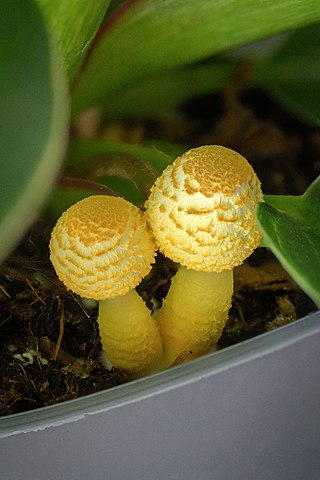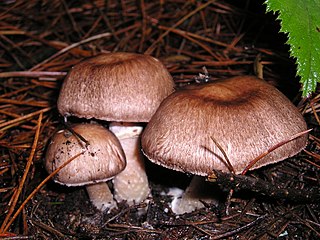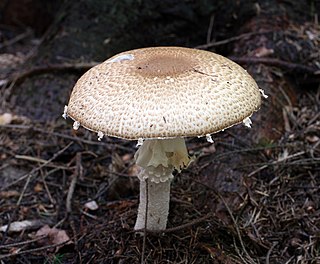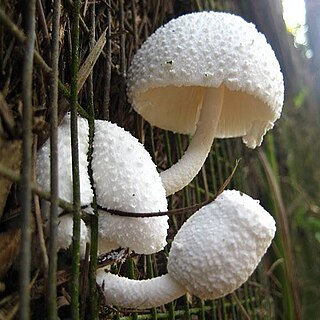
Mycology is the branch of biology concerned with the study of fungi, including their taxonomy, genetics, biochemical properties, and use by humans. Fungi can be a source of tinder, food, traditional medicine, as well as entheogens, poison, and infection. Mycology branches into the field of phytopathology, the study of plant diseases. The two disciplines are closely related, because the vast majority of plant pathogens are fungi. A biologist specializing in mycology is called a mycologist.

Agaricus bisporus, commonly known as the cultivated mushroom, is a basidiomycete mushroom native to grasslands in Eurasia and North America. It is cultivated in more than 70 countries and is one of the most commonly and widely consumed mushrooms in the world. It has two color states while immature – white and brown – both of which have various names, with additional names for the mature state, such as chestnut, portobello, portabellini, button and champignon de Paris.

Agaricus is a genus of mushroom-forming fungi containing both edible and poisonous species, with over 400 members worldwide and possibly again as many disputed or newly-discovered species. The genus includes the common ("button") mushroom and the field mushroom, the dominant cultivated mushrooms of the West.

Agaricus impudicus, also known as the tufted wood mushroom, is a mushroom of Agaricus, a genus with many edible species.

Leucocoprinus birnbaumii, commonly known as the flower pot parasol, yellow parasol, flowerpot parasol, or plantpot dapperling, is a species of gilled mushroom in the family Agaricaceae. It is common in the tropics and subtropics. However, in temperate regions, it frequently occurs in greenhouses and flowerpots, hence its common names of flowerpot parasol and plantpot dapperling. It is considered to be toxic if consumed.

Agaricus campestris is a widely eaten gilled mushroom closely related to the cultivated A. bisporus. A. campestris is commonly known as the field mushroom or, in North America, meadow mushroom.

Agaricus subrutilescens, also known as the wine-colored agaricus, is a mushroom of the genus Agaricus. It was first described scientifically in 1925 as Psalliota subrutilescens, and later transferred to Agaricus in 1938.

Agaricus augustus, known commonly as the prince, is a basidiomycete fungus of the genus Agaricus.

Agaricus bernardii, commonly called the salt-loving agaricus, or salty mushroom, is an agaric fungus in the family Agaricaceae. The mushroom's thick stem is usually shorter than the diameter of the cap, which ranges from 5–15 centimetres and is convex to flattened. The cap surface is whitish to buff, and can develop scales or warts in age. The gills are initially pink before turning brown when the spores mature. The flesh turns reddish when it is cut or bruised. It resembles species such as A. bitorquis.

Lactarius blennius is a medium-sized mushroom of the genus Lactarius found commonly in beech forests in Europe, where it is mycorrhizal, favouring the European beech. It was first described by Elias Magnus Fries. Though its colour and size vary, it is distinctive because it is slimy when wet and exudes copious amounts of milk. It has been the subject of some chemical research, and it can be used to produce pigments and blennins. Blennins, some of which have shown potential medical application, are derived from lactarane, a chemical so named because of their association with Lactarius. The edibility of L. blennius is uncertain, with different mycologists suggesting that it is edible, inedible or even poisonous.

Mycena haematopus, commonly known as the bleeding fairy helmet, the burgundydrop bonnet, or the bleeding Mycena, is a species of fungus in the family Mycenaceae, of the order Agaricales. It is widespread and common in Europe and North America, and has also been collected in old Japan and Venezuela. It is saprotrophic—meaning that it obtains nutrients by consuming decomposing organic matter—and the fruit bodies appear in small groups or clusters on the decaying logs, trunks, and stumps of deciduous trees, particularly beech. The fungus, first described scientifically in 1799, is classified in the section Lactipedes of the genus Mycena, along with other species that produce a milky or colored latex.

Agaricus deserticola, commonly known as the gasteroid agaricus, is a species of fungus in the family Agaricaceae. Found only in southwestern and western North America, A. deserticola is adapted for growth in dry or semi-arid habitats. The fruit bodies are secotioid, meaning the spores are not forcibly discharged, and the cap does not fully expand. Unlike other Agaricus species, A. deserticola does not develop true gills, but rather a convoluted and networked system of spore-producing tissue called a gleba. When the partial veil breaks or pulls away from the stem or the cap splits radially, the blackish-brown gleba is exposed, which allows the spores to be dispersed.

Amanita ceciliae, commonly called snakeskin grisette, strangulated amanita, and the Cecilia's ringless amanita, is a basidiomycete fungus in the genus Amanita. First described in 1854 by Miles Joseph Berkeley and Christopher Edmund Broome, it was given its current name by Cornelis Bas in 1984. It is characterized by bearing a large fruit body with a brown cap 5–12 cm (2.0–4.7 in) across. The cap has charcoal-grey patches, which are easily removable. The stipe is 7–18 cm (2.8–7.1 in) long, white in colour, and there is no ring on it. It is slightly tapered to the top, and has irregular cottony bands girdling the base. The universal veil is grey. Spores are white, spherical in shape, non-amyloid, and measure 10.2–11.7 micrometres. The mushrooms are considered edible, but field guides typically advise caution in selecting them for consumption, due to risks of confusion with similar toxic species. A. ceciliae is found in woods throughout Europe and North America, where it fruits during summer and autumn.

Leucocoprinus fragilissimus, commonly known as the fragile dapperling, is a species of gilled mushroom in the family Agaricaceae.
Louis Charles Christopher Krieger was an American mycologist and botanical illustrator who was considered the finest painter of North American fungi.

Leucocoprinus cretaceus is a species of mushroom producing fungus in the family Agaricaceae. It is likely tropical in origin although it was first documented in Europe where it was often found growing in greenhouses and bark beds. However many early observations conflate this species with Leucocoprinus birnbaumii or Leucocoprinus cepistipes despite sharing only some superficial similarities. This fungus is quite versatile even for a saprotroph and is often found growing in clusters on woodchips, sawdust and compost heaps as well as directly from the ground or on trees. It may also appear in plant pots and greenhouses in colder countries in which it is not well equipped to survive outside.

Leucoagaricus gongylophorus is a fungus in the family Agaricaceae which is cultivated by certain leafcutter ants. Like other species of fungi cultivated by ants, L. gongylophorus produces gongylidia, nutrient-rich hyphal swellings upon which the ants feed. Production of mushrooms occurs only once ants abandon the nest. L. gongylophorus is farmed by leaf cutter ant species belonging to the genera Atta and Acromyrmex, amongst others.
Gábor Bohus (1914–2005) was a Hungarian mycologist born on 4 July 1914 in Budapest.















